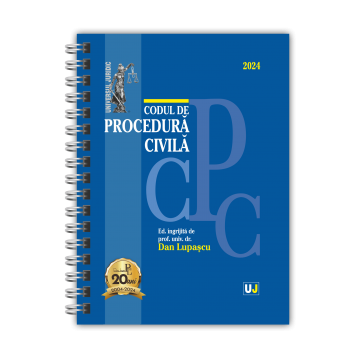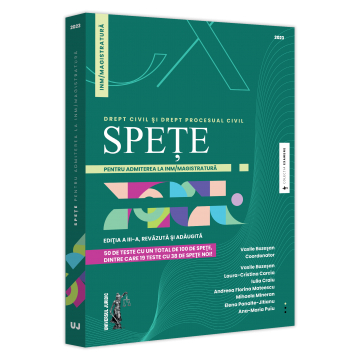ISBN: 978-606-28-0659-0
DOI: 10.5682/9786062806590
Publisher year: 2017
Pages: 298
Publisher: Editura Universitara
Author: Raluca Papadima
- Description
- Download (1)
- Authors
- Content
- More details
- Where to find it
- Reviews (0)
-
ANGLO-SAXON BUSINESS AND CONTRACT LAW
Download
Raluca Papadima is a member of the Bucharest (2004), Paris (2006) and New York Bar (2007). She currently practices law in the United States and Romania, specializing in transactions and dispute resolution with an international component. Ms. Papadima is also an Adjunct Professor at the University of Bucharest (Faculty of Law and Faculty of Administration and Business) and the Collège Juridique Franco-Roumain, where she teaches Romanian, French and American, European and International Business Law and Contract Law. She has authored numerous articles published in prestigious Romanian and foreign law reviews.
Ms. Papadima graduated from the Faculty of Law of the University of Bucharest and the Collège Juridique Franco-Roumain (2003) and holds a master in Business Law from the University of Paris 2 Panthéon-Assas (2004), a master in Corporate Law and Governance from Harvard University (2006) and a PhD from the University of Paris 2 Panthéon-Assas (2017).
During 2004-2006, Ms. Papadima worked as an attorney at Linklaters LLP (Bucharest and Paris) and during 2006-2016, she worked as an attorney specialized in Mergers & Acquisitions at, Latham & Watkins LLP (New York) and Greenberg Traurig LLP (New York). She also has significant experience in commercial arbitration. Ms. Papadima is the President of the Vindobona Association for the Promotion of Arbitration in Romania and a registered arbitrator with the Court of International Commercial Arbitration of the Romanian Chamber of Commerce. She is also a constant member since 2005 of the jury for the Willem Vis moot court competition in international arbitration.
Introduction Civil Law versus Common Law / 7
Topic 1 Anglo-Saxon Business Law / 20
I. American Business Law / 20
II. English Business Law / 24
Topic 2 Anglo-Saxon Contract Law / 44
I. American Courts and Case Law / 44
II. English Courts and Case Law / 51
Topic 3 Anglo-Saxon Business Contracts in Theory / 62
I. Anglo-Saxon Law Applicable to Contracts Other Than for the Sale of Goods / 62
A. Drafting Anglo-Saxon Contracts / 63
B. Interpreting Anglo-Saxon Contracts / 80
II. Anglo-Saxon Law Applicable to Contracts for the Sale of Goods / 83
A. Contracts for the Sale of Goods under the UCC / 83
1. Sphere of application of Article 2 UCC (Sales) / 83
2. Formation of the contract and form requirements / 84
3. Warranties / 87
4. Buyer Remedies / 88
5. Seller Remedies / 89
B. Contracts for the Sale of Goods under the CISG / 90
1. Structure of the CISG / 90
2. Sphere of application of the CISG / 90
3. Interpretation of the CISG and of contracts under the CISG / 91
4. Formation of the contract and form requirements / 92
5. Seller’s obligations and buyer’s remedies / 92
Topic 4 Anglo-Saxon Business Contracts in Practice / 104
I. Contracts for the Sale of Goods / 104
A. Sale of Technology / 104
B. Sale of Wine / 111
II. Contracts for the Sale of Companies / 119
A. Sale of a Public Company / 119
B. Sale of a Private Company / 138
1. Background Information / 138
2. Due Diligence (Company’s response to the Buyer’s
due diligence request) / 140
3. Data Room (Documents provided by the Company
and the Sellers / 150
3.1 Certificate of Incorporation / 150
3.2 Organizational Resolutions / 154
3.3 Bylaws / 155
3.4 Stockholders Agreement / 172
3.5 Stock Certificates / 187
3.6 Patent License Agreement between the Company and Diamond Cutters / 190
3.7 Equipment Lease Agreement between the
Company and Protect Your Stuff / 196
3.8 Supply Agreement between the Company and
Jimmy Gems / 199
3.9 Employment Agreement between the Company and Donald Diamond / 205
3.10 Business License of the Company from the City of Chicago / 221
3.11 Line of Credit Agreement between the Company and Mo Money Bank / 222
3.12 Chart of Lien Search Results / 231
3.13 List of Customers and Suppliers / 232
4. Stock Purchase Agreement (Buyer’s markup of Sellers’ draft) / 233
5. Due Diligence Report (Memorandum Prepared by Counsel to the Buyer) / 265
6. Issues List Report (Memorandum Prepared by Counsel to the Sellers) / 273
7. Disclosure Schedules (Draft Prepared by Counsel to the Sellers) / 281
8. M&A Deal Terms Study / 288
Bibliography / 298
CIVIL LAW VERSUS COMMON LAW
Civil law countries: France, Germany, Belgium, Netherlands, Spain, Italy, Romania
Common law countries: United Kingdom, Ireland, United States, Canada, Australia, New Zealand, India, Pakistan, Nigeria, Bangladesh, Malaysia, Ghana, Sri Lanka, Hong Kong, Singapore, Burma, Israel, Papua New Guinea, Jamaica, Trinidad and Tobago, Cyprus, Antigua and Barbuda, Bahamas, Barbados, Belize, Dominica, Grenada, Marshall Islands, Micronesia, Nauru, Palau, Zimbabwe, Cameroon, Namibia, Liberia, Sierra Leone, Botswana, Guyana, Fiji.
Mixed countries: Louisiana, Québec, Scotland, South Africa.
History and Development
Civil law. The phrase comes from the Latin “jus civile” (as opposed to “jus gentium”), the law originally applicable only to the Roman citizens.
Common law. The English common law (as opposed to “statutory law”) originated in the king’s courts, which created the first uniform rules. It did not originally consist of substantive rights but rather of procedural remedies (“writs”). The common law includes two branches: “law” (monetary remedies) and “equity” (non-monetary remedies, such as specific performance, rescission, injunction, rectification).
The equity branch is based on the principles of fairness and natural justice.
In the United Kingdom, the common law courts and the equity courts merged (Judicature Acts of 1873-1875). We will see that the equity litigation is handled by the Chancery Division of the High Court.
In the United States, the federal courts and most state courts have progressively merged law and equity in the courts of general jurisdiction. The movement for merger of law and equity began in the mid-19th century (for example, the state of New York adopted the Field Code in 1848-1850). However, the substantive distinction between law
and equity has retained its importance and the difference is not a mere technicality. For example, certain statutes specifically authorize only equitable relief, which forces courts to analyze in lengthy detail whether the relief demanded in particular cases brought under those statutes would have been available in equity. Today, only a handful of states still have separate courts for law and equity. The most notable is the state of Delaware. The Delaware Court of Chancery is where most cases involving Delaware corporations are decided. Moreover, the merger of law and equity courts in some states is less than complete. Some other states (for example, Illinois and New Jersey) have separate divisions for legal and equitable matters in a single court. Finally, bankruptcy was also historically considered an equitable matter. Although bankruptcy is today a purely federal matter in the United States, bankruptcy courts are still officially considered “courts of equity” and exercise equitable powers under the Bankruptcy Code.
Legislation and Judicial Decisions
Legislation as the basis of the civil law. Generally, in civil law countries, the main source or basis of the law is legislation, and large areas are codified in a systematic manner.
Judicial decisions as the basis of the common law. The common law designates the customary and unwritten laws as embodied in old cases and commentaries. As a body of law, it consists of all the rules that can be generalized out of judicial decisions. The common law is applied based on the doctrine of “precedent” and the principle of “stare decisis” (“stand by what has been decided”).
In common law countries, earlier cases (precedents) have decisive (binding) authority.
Judicial decisions are both the source and the proof of the law.
Ratio decidendi: The main legal reason, the exact point which was indispensable and necessary to reach the decision that was reached by the judge.
Obiter dicta: “By the way” statements, non-essential statements which are not binding.
If a new situation resembles a prior case but is not exactly the same, the judge has three options: (i) “apply” the rule of the earlier case nevertheless, (ii) “distinguish” the earlier case and leave its application limited to the specific fact situation which it controlled or (iii) “overrule” the earlier case (very rarely, only in extreme circumstances, if the judge believes that the earlier case was erroneously decided).
Legislation in the common law. There is also legislation (“statutory law”) in common law countries (typically called “acts” or “statutes”). Contrary to codes found in civil law countries, common law legislation is usually not formulated in terms of genera principles but consists rather of particular rules intended to control certain fact situations specified with considerable detail.
Example (United Kingdom): Companies Act (adopted in 2006, as subsequently amended)
Example (United States): Uniform Commercial Code (adopted in 1952, as subsequently amended)
European civil law has profoundly impacted common law in the United Kingdom (adoption of the European Convention on Human Rights ratified by the United Kingdom in 1949, joining of the European Union by the United Kingdom in 1973).
Judicial decisions in the civil law. In civil law countries, earlier cases have only persuasive authority, in the sense that courts are not bound to follow previous judicial decisions. The function of the courts is merely to “apply” (but also to “interpret”) the written law. The utilization of prior decisions is mainly on points of interpretation of the written texts. Certain decisions do however have binding force even in civil law countries.
Example (France, Belgium): “jurisprudence constante” (constant manner of deciding certain cases)
Examples (Romania): “recursul in interesul legii” (appeal “in the interest of the law” before the Supreme Court of Romania, Inalta Curte de Casatie si Justitie), decisions of the Romanian Constitutional Court, decisions involving abusive clauses in standard, non-negotiated, contracts between professionals (for example, banks) and consumers
Doctrinal Materials, Legal Education and Research
Doctrinal materials. In civil law countries, the treaties and commentaries of legal writers are generally expressed in the form of systematic expositions and in discussions about broad legal principles. The doctrine is an inherent part of the legal system and, even if it is not a recognized source of law, it exercises a great influence in the development of the law. In common law countries, there is not as large a quantity of doctrinal writings, and these are likely to consist of analyses of decided cases.
Customer Support Monday - Friday, between 8.00 - 16.00
0745 200 718 0745 200 357 comenzi@editurauniversitara.ro
6359.png)
![Anglo-Saxon Business and Contract Law [1] Anglo-Saxon Business and Contract Law [1]](https://gomagcdn.ro/domains/editurauniversitara.ro/files/product/large/anglo-saxon-business-and-contract-law-361-633539.jpg)














